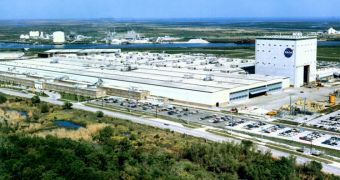Engineers at the American space agency conducted an innovative test yesterday, March 23, which saw a simulation of a rocket stage getting crushed into a pulp. Results obtained from this could in the future help delivery system builders and designers create more reliable heavy-lift rockets.
Structural strength tests such as this one are a tremendously important part of the vehicle development process, say experts with the NASA Marshall Space Flight Center (MSFC), in Huntsville, Alabama.
At this point, there are two main objectives that space agencies and their contractors seek to attain – reducing launch weight and diminishing development costs. There are several ways of achieving this, but test results must guide constructors on the one that is the safest for passengers or cargo.
What NASA accomplished with the new crush test is that it got a good view on the safety margins that rockets have when subjected to tremendous forces. This will be invaluable as experts develop future, large launch vehicle structures.
“This type of research is critical to NASA developing a new heavy-lift vehicle,” explains Charles Bolden, the NASA Administrator. Data from the new tests will be used to develop and validate new structural analysis models and complex engineering design standards (EDS).
“The Authorization Act of 2010 gave us direction to take the nation beyond low-Earth orbit, but it is the work of our dedicated team of engineers and researchers that will make future NASA exploration missions a reality,” Bolden adds.
Among rocket manufacturers, the EDS needed to design delivery systems are called shell buckling knockdown factors. At many companies, they date back to the Apollo era, which is when most of the studies on the most commonly-used materials were carried out.
However, at that time, advanced materials, manufacturing processes and high-fidelity computer modeling was not available to engineers. They are today, and so new studies are needed in order to seamlessly incorporate the new abilities into the most modern vehicles.
“Launch vehicles are thin walled, cylindrical structures and buckling is one of the primary failure modes. Only by studying the fundamental physics of buckling through careful testing and analysis can we confidently apply the new knowledge to updated design factors,” explains Mark Hilburger.
“The outcome will be safer, lighter, more efficient launch vehicles,” adds the expert, who is the principal investigator of the Shell Buckling Knockdown Factor project at the NASA Engineering and Safety Center (NESC).
The NESC and the NASA Langley Research Center in Hampton, Virginia are leading the project. Hilburger is also a senior research engineer in the Structural Mechanics and Concepts Branch at Langley.
“Marshall's Structural and Dynamics Engineering Test laboratory is uniquely suited for shell buckling testing,” adds MSFC engineer Mike Roberts, who is based at the structural strength test branch.
“Originally built to test Saturn rocket stages, the capabilities found here were essential to developing the lightweight space shuttle external tank flying today and for testing International Space Station modules,” he concludes.

 14 DAY TRIAL //
14 DAY TRIAL //